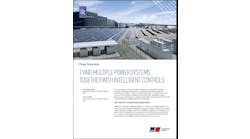The U.S. Army Engineer Research and Development Center (ERDC) has unveiled the Army’s first fully self-sufficient hydrogen-powered nanogrid.
Located at the White Sands Missile Range (WSMR) in New Mexico, the demonstration project is designed for continuous, unattended operation in a remote, off-grid location.
A nanogrid is essentially a smaller version of a microgrid. It is a self-contained electric power generation system that can operate independently from the power grid.
Developed by Michigan-based Sesame Solar, the WSMR nanogrid includes solar panels, an atmospheric water generator and an electrolyzer to split the hydrogen from water. It also features a fuel cell, low pressure hydrogen storage and battery energy storage.
Compact and mobile, the nanogrid’s components are housed in a Conex box, a type of shipping container developed by the Army after World War II.
“I am thrilled to demonstrate the Army’s first renewable energy nanogrid,” Carol Bailey, project manager from ERDC's Construction Engineering Research Laboratory, said in a statement. "The hydrogen-powered nanogrid offers a carbon-free alternative that is both sustainable and effective for applications in extreme weather environments and sensitive cultural areas such as WSMR.”
“Silent watch”
The nanogrid is being installed in the WSMR cantonment area, military parlance for the residential part of a military base, an area that’s also home to a variety of wildlife. It will power a surveillance camera system and Starlink connection for the Directorate of Public Works (DPW) Environmental Division at WSMR.
The “silent watch” capabilities offered by the hydrogen-powered system will help that group achieve its mission of conserving, protecting and managing local wildlife in a way that a noisy diesel-powered generator could not.
The system is “designed to detect and alert birds and mammals that I can then view and identify from my office computer,” said Trish Cutler, wildlife biologist for the DPW Environmental Division at WSMR. “The data provides an opportunity to help deconflict human interactions with African oryx, javelina, and carnivores such as coyotes, mountain lions and bobcats.”
Nanogrid to support atmosphere and energy research
While perhaps best known as a missile testing site, the White Sands Missile Range is one of the top research, development and testing sites for a variety of military and civilian technologies. More than 3,000 tests are conducted across the 3,200 square mile installation each year.
The nanogrid will also power a weather station for the Army Research Laboratory’s Atmospheric Intelligence for Hybrid Power Advancements (AIHPA) team, which conducts atmospheric and energy research on the base.
It provides “a unique opportunity to explore atmospheric effects and power production processes associated with hydrogen fuel cells, resulting in the rare ability to directly operationalize scientific findings,” said Gail Vaucher, AIHPA leader.
Army will launch second hydrogen nanogrid this year
The Army is planning to deploy a second hydrogen-fueled nanogrid this year in Missouri at Fort Leonard Wood, according to Bailey. The demonstration will focus on the system’s mobility capabilities and will also feature an electric vehicle charging port.
Fort Leonard Wood commissioned a long-duration energy storage system at its Contingency Basing Integration Training Evaluation Center last year.
"Demonstrating the capabilities of a hydrogen-fueled nanogrid in real-time operational environment shows the art of the possible with renewable energy. The rugged design and renewable energy sources provide a prototype smart energy system that can be deployed in a variety of environments,” Bailey said.








